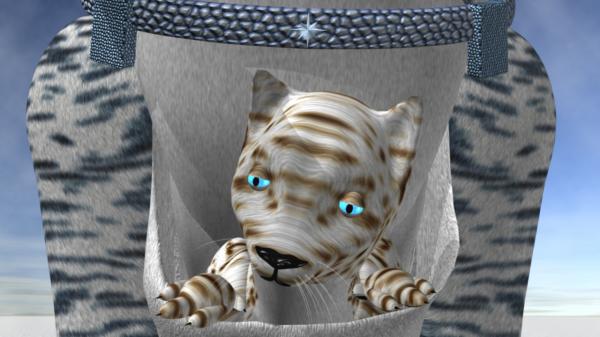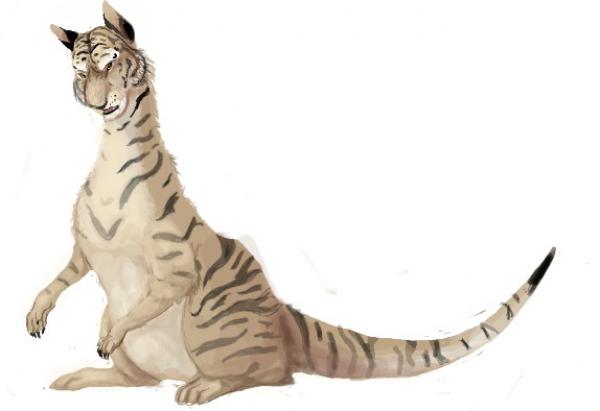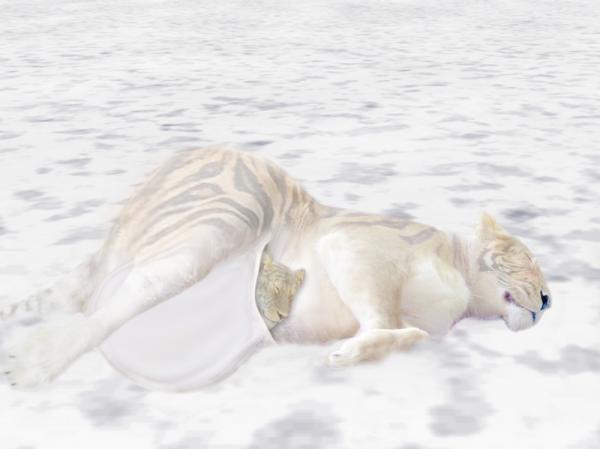BY LETTER
Siberoo
Zoosplice Provolve sophont clade based on synthesis of Siberian tiger and red kangaroo | |
 Image from Darren Ryding | |
| Rantreleka - a Siberoo Joey | |
The Siberoo is a zoosplice/provolve species first developed in 280 AT; originally a barely sapient combination of Siberian tiger and red kangaroo, with small traces of polar bear and Alaskan malamute.
Right from the start, Siberoos were gifted with extraordinarily sharp senses; their hearing, smell and night vision were the equal of any "natural" mammal. Early uses of the Siberoo were in the polar regions of Earth, where they were trained to sniff out humans trapped under snow or ice, and dig them out with their extremely powerful and dexterous paws. The massive female marsupials were invaluable, since they could carry snow victims back to base and keep them warm at the same time. The superior speed and agility of the males made them essential for search-and-rescue operations; yet these qualities were more than complemented by the females— sheer robustness, stamina and carrying capacity.
 Image from Lectabat |
The average female was stoutly built, weighing from 1.5 to 2 metric tons at a height of 3.6 metres, with a maximum pouch capacity of over 200 kilograms. The smaller, leaner male averaged 300 kilograms at 2.7 metres high. This obvious dimorphism led many humans of the time to refer to the two sexes as "jeeps and tanks". While both males and females ran in long, powerful strides (like bipedal dinosaurs), both were also capable of leaping extraordinary distances when necessary. The males far more frequently utilized this latter ability.
A fraction of the females at any given time were reserved for breeding purposes, while the rest kept their pouches vacant for passengers or rescue victims. Most females, however, would become both rescuers and breeders within the course of their lifetimes. A healthy, well-fed female was impervious to even the most violent snowstorm. Almost any pouch passenger would have been equally invulnerable, separated from the freezing air by thick layers of hide, fat and fur, enclosed by a muscular opening that — as with many natural marsupials — was potentially watertight.
 Image from Darren Ryding |
Even the early Siberoos were intelligent enough to search for snow victims without the help of a rider. Adults developed a verbal recognition vocabulary equivalent to an average eight-year-old baseline human. This enabled them to follow specific verbal directions, read signs, use various tools for self-grooming and cleaning, and even enjoy motion pictures during their time off. The occasional use of vocalizer implants made human/Siberoo communication even broader (though not without occasional confusion). To compensate for whatever they lacked, many Siberoos carried turingrade accessories and sensory enhancers while on duty, while human riders were often seen on specially designed saddles for the Siberoos' sloping backs.
Indesigen, the superbright-led multinational corporation responsible for creating and nurturing the Siberoo species (among others), generated some ingenious marketing campaigns to finance the care and breeding of Siberoos. These ranged from Siberoo rides for tourists in snowy regions to sales of sculptures, posters, plush toys, virtual characters and other merchandise. One early arctic tourism advertisement began with a close-up of a woman apparently wearing a fur-lined Inuit hood. The point-of-view zoomed out to reveal that the fur around her head was really the pouch opening of a Siberoo. This advertisement alone is considered largely responsible for a sharp spike in arctic tourism. At this stage, Indesigen was already extending their considerable provolution budget to many Siberoos, for reasons both practical and sentimental. By 420 AT some fully sapient, speaking Siberoos occupied executive positions in polar research bases and tourist resorts. Their full support of further provolution ensured the exponential rise of sapient Siberoos over the following century. A noteworthy percentage of Siberoos who immigrated to slightly warmer regions became active in art and entertainment, particularly male virch sculptor Hieronymous Frost and action/adventure actress Fluffy Steele.
The popularity of these majestic beasts was so huge that, during the 330—s AT, there was a disturbing trend in which tourists would deliberately get themselves lost in the snow just to be rescued by a Siberoo. Evidently, they seemed to ignore the fact that they could get a Siberoo ride for a little more money and a little less bodily trauma.
It was one of history—s great ironies that the most famous Siberoo of this era was not one of flesh and blood, but every bit as self-aware. It was the virch aioid Selena, who played a nightclub-singing superheroine in the hugely popular virch series Arctic City. Many of her fans were actual Siberoos, who saw her as a positive (if bizarre) role model. Selena—s stylized, anthropomorphic features contrasted sharply with the more natural feline characteristics of "real" Siberoos. The contrast became most apparent when she made virtual contact with her Siberoo fans.
Thousands of Siberoos (mostly provolved) were evacuated from Earth during the Technocalypse of the late Interplanetary Age. In the millenia that followed, the great majority of Siberoos possessed intelligence well into the nearbaseline range, with a minority becoming superbright and (more rarely) transapient. The Siberoos on the frozen planet of Kragliath eventually gengineered themselves into the (mostly isolationist) Megasibers; sauropod-sized, four legged felinoids with backward facing pouches, extremely dexterous tails and exceptionally thick layers of hide and blubber.
 Image from Darren Ryding |
Many baseline Siberoos continued to happily perform their original function on small, frigid planetary colonies, while others spread throughout the Terragen Sphere, finding work and companionship in a wide variety of fields. It is estimated that tens of millions of baseline Siberoos (and more from derivative clades) live within the Terragen Sphere today, particularly in the NoCoZo, Utopia Sphere and Zoeific Biopolity.
Siberoo religions, though varied, are largely goddess-oriented due to the sheer size and dominance of the females, as well as the very clear memories of living in a female's pouch. While their political philosophies are even more varied, the most common thread involves a sense of rugged individualism for most of the time combined with community spirit in special situations. This balanced combination of individualism and altruism is largely influenced by the Siberoos' marsupial life cycle.
 Image from Darren Ryding |
Many Siberoos tend to be fond of combat sports, and even joeys often enjoy one-on-one wrestling matches. However, due to the ethics of fair play and mutual respect that they are taught from an early age, young Siberoos avoid wrestling matches with the opposite sex during early adolescence, when the females rapidly begin to outgrow the males. Bullying a weaker individual — especially one of another species — is considered a low and cowardly act and the perpetrator is typically ostracized.
It is rumoured that the newly transcended Zoeific godling Halatajah was once a Siberoo; however, this has not been confirmed.
Related Articles
Appears in Topics
Development Notes
Text by Darren Ryding
Initially published on 19 December 2002.
Initially published on 19 December 2002.






